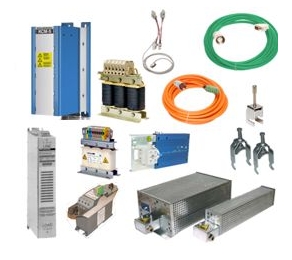EMC Line Filters
EMC mains filters are necessary in most applications in order to comply with European regulations regarding line feedback. In some controllers the line filters are already integrated, in others they must be added.
In most applications we use the following SCHAFFNER filters:
- FN351-5/29: 3x400Vac, 5A cont.
- FN351-8/29: 3x400Vac, 8A cont.
- FN351-16/29: 3x400Vac, 16A cont.
- FN350-8/29: 1x250Vac, 8A cont.
- FN350-12/29: 1x250Vac, 12A cont.

MOTOR CHOKES / MOTOR FILTERS
In many applications motor chokes help to achieve optimum performance. Be it that the motor inductance has to be adapted to the amplifier or that the motor currents have to be smoothed for quieter running or optimum EMC properties.
The following motor chokes are part of our standard product range:
- L100/3K: 1mH, 3A nominal, DxH 45 x 30mm (plus connector), 0.25kg
- L020/6K: 0.2mH, 6A nominal, DxH 45 x 30mm (plus connector), 0.25kg
- L050/8K: 0.5mH, 8A nominal, DxH 60 x 41mm (plus connector), 0.6kg
- L012/20K: 0.12mH, 20A nominal, DxH 60 x 41mm (plus connector), 0.6kg
A special feature is the motor filter from Copley: most of the interference components are capacitively transferred from the motor cable to the adjacent cables. In order to minimize this interference, the XTL-FA-01 motor filter uses both a differential filter and common-mode suppression. The differential filter reduces the high-frequency noise from the PWM clocking, while the common-mode rejection reduces the noise generated by the PWM signals.
The differential filter increases the rise time by at least a factor of 3, which significantly minimizes the interference due to the changed frequency spectrum. Copley amplifiers typically have a rise time of 150ns (high frequency component in the MHz range). With the Edge Filter, the rise time can therefore be increased to 500ns - with a quadratic drop in interference. The differential filter consists of inductors and a proprietary passive circuit. The additional inductance reduces the current ripple and also allows the use of low-inductance motors.
BRAKING REGENERATION RESISTORS
If the regenerative energy cannot be fed back into the mains supply when a motor is braked (which is only worthwhile for larger power ratings), the voltage in the DC link will increase.
In order to protect the electronics, it must be ensured that the excess energy is dissipated when a specified voltage is exceeded. For this purpose, modern servocontrollers usually have an integrated ballast circuit and sometimes also an internal braking resistor. If this is not available or the power is insufficient, external braking resistors must be connected.
SERVO CAPACITOR MODULE KCM
The KCM modules absorb kinetic energy generated by the motor in generator operation. Normally this energy is converted into power loss via braking resistors. The KCM modules feed the stored energy back into the DC bus when it is needed. The module is available in 3 different versions.
KCM-S Saves energy: the energy stored in the capacitor module during regenerative braking is available for the next acceleration case. The input voltage of the module is automatically determined during the first load cycles.
KCM-P Power despite power failure: if the power supply fails, the module makes the stored energy available to the servo amplifier for a controlled shutdown of the drive (power voltage only, 24V buffer separately).
KCM-E expansion module: for both purposes. Expansion modules are available in two capacity classes. The modules can be combined as required.



 PDF Kollmorgen Accessories for Servo Drives Catalogue
PDF Kollmorgen Accessories for Servo Drives Catalogue


 PRINT PAGE |
PRINT PAGE |